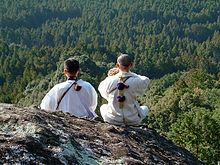Shugendō
Shugendō is a religion that originated in Japan during the Nara Period. It combines beliefs, philosophies, doctrines, and ritual systems from local folk religions,[1] Shinto mountain worship, and Buddhism. Shugendō is a highly syncretic religion and is considered a body of ascetic practices. The goal of Shugendō is for practitioners to find supernatural power and save themselves and others by conducting religious training while walking through steep mountain ranges. Those who practice Shugendō are called Shugenja or Yamabushi, which means "Mountain Prostrator". The practice of Shugendō takes place on mountains all over Japan, including various mountains in the Ōmine mountain range, such as Mount Hakkyō and Mount Ōmine.[2]





The Shugendō worldview incorporates a vast array of deities, including figures from both Buddhism and Shintoism. Two significant figures are the tantric Buddhist deities of Fudō Myōō and Dainichi Nyorai.[3] Gongen is another essential figure in Shugendō, referring to the manifestation of Buddhas as Japanese Kami. One of the most significant Gongen in Shugendō is Zaō Gongen..[4][5]
Gallery
change-
Picture of Yamabushi (mountain ascetic practitioners) on the Ōmine Okugakemichi trail near Yoshino, Japan.
-
Monk at Shippōryū-ji Temple supervises an ascetic waterfall exercise.
-
Mount Kongo (Kongosanchi) Syugenja
Related pages
changeReferences
change- ↑ Sekimori, Gaynor (2009). "Defining Shugendō Past and Present: The "Restoration" of Shugendō at Nikkō and Koshikidake". Cahiers d'Extrême-Asie. 18 (1): 47–71. doi:10.3406/asie.2009.1330.
- ↑ "Exoteric Buddhism, Esoteric Buddhism, and Shugendo – 顕教・密教・修験道". www.tendai-jimon.jp. Tendaijimon Sect. Archived from the original on 21 December 2020. Retrieved 31 January 2021.
- ↑ Miyake Hitoshi. "Religious Rituals in Shugendo A Summary." Japanese Journal of Religious Studies 1989 16/2–3
- ↑ "修験道とは・・・「自然と人間」". Tendaijimon Sect. Archived from the original on 21 December 2020. Retrieved 31 January 2021.
- ↑ Masayasu Oda. "The Formation and its Meaning of the 75-sacred-place View in the Omine Sacred Mountain Area". Archived from the original on 2 May 2019. Retrieved 2 February 2021.
Sources
change- A Look at Japanese Ascetic Practice
- Head Temple Takao-san Yakuo-in Central Shugendo Training Center in Kanto
- 天台寺門宗|修験道
- Shugen: The Autumn Peak of Haguro Shugendo
- Mount Fuji and Shugendo
- Shugendo article in Buddhism & Shinto in Japan: A-to-Z Photo Dictionary of Japanese Religious Sculpture & Art
- Shugendo - History of Japan Database